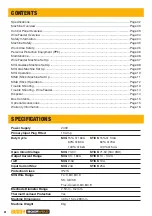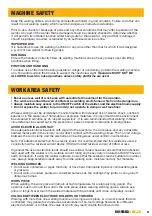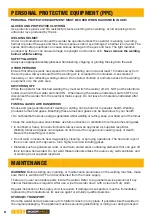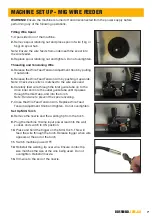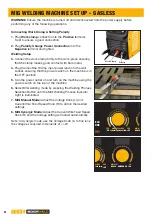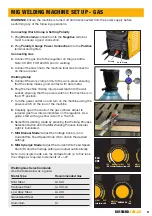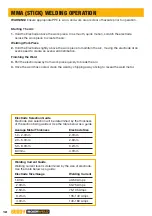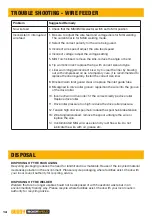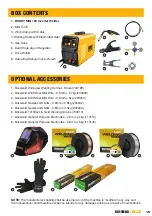
5
bossweld
.com.au
• Ensure a clear, well lit work area with unrestricted movement for the operator.
• The work area should be well ventilated, as welding emits fumes which can be dangerous.
• Always maintain easy access to the ON/OFF switch of the welder, and the electrical mains supply
• Do not expose the welder to rain and do not operate in damp or wet locations
Where welding must be undertaken in environments with increased risk of electric shock, confined
spaces or in the presence of flammable or explosive materials, it is important that the environment
be evaluated in advance by an “expert supervisor”. It is also recommended that welding in these
circumstances be carried out in the presence of persons trained to intervene in emergencies.
AVOID ELECTRICAL CONTACT
Use adequate electrical insulation with regard to the electrode, the work piece and any accessible
earthed metal parts in the vicinity. Avoid direct contact with the welding circuit. The no load voltage
between the work clamp and the electrode can be dangerous under certain circumstances.
Note: For additional protection from electric shock. It is recommended that this welder be used in
conjunction with a residual current device (RCD) with rated residual current of 30MA or less.
In general the use of extension leads should be avoided. If used however, ensure that the extension
lead used with the welder is of a suitable current rating and heavy duty in nature that MUST have an
earth connection. If using the welder outdoors, ensure that the extension lead is suitable for outdoor
use. Always keep extension leads away from the welding zone, moisture and any hot materials.
WELDING SURFACES
•
Do not weld containers or pipes that hold, or have held, flammable liquids or combustible gases
or pressure.
• Do not weld on coated, painted or varnished surfaces as the coatings may ignite, or can give off
dangerous fumes.
WORK PIECE
When welding, the work piece will remain at high temperature for a relatively long period. The
operator must not touch the weld or the work piece unless wearing welding gloves. Always use
pliers or tongs. Never touch the welded material with bare hands until it has completely cooled
VOLTAGE BETWEEN ELECTRODE HOLDERS OR TORCHES
Working with more than one welding machine on a single work piece, or on work pieces that are
connected, may generate a dangerous accumulation of no-load voltage between two different
electrode holders or torches, the value of which may reach double the allowed limit.
Keep the welding cables, work clamp and electrode holder in good condition. Failure to do this can
result in poor welding quality, which could be dangerous in structural situations.
Prior to use, check for breakage of parts and any other conditions that may affect operation of the
welder. Any part of the welder that is damaged should be carefully checked to determine whether
it will perform its intended function whilst being safe for the operator. Any part that is damaged
should be properly repaired, or replaced by an authorised service centre.
IMPROPER USE
It is hazardous to use the welding machine for any work other than that for which it was designed
e.g. do not use welder for thawing pipes.
HANDLING
Ensure the handle is correctly fitted. As welding machines can be heavy, always use safe lifting
practices when lifting.
POSITION AND HANDLING
To reduce risk of the machine being unstable / danger of overturning, position the welding machine
on a horizontal surface that is able to support the machine weight.
Operators MUST NOT BE
ALLOWED to weld in raised positions unless safety platforms are used.
MACHINE SAFETY
WORK AREA SAFETY


